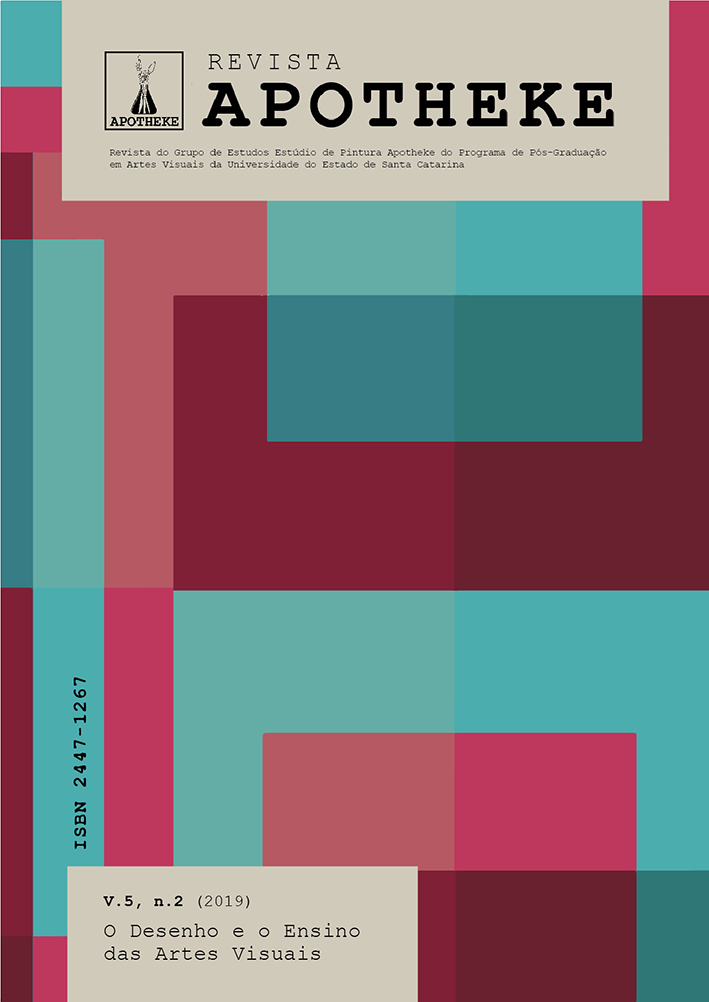O desenho como membrana: processos, aprendizados e compartilhamentos
DOI:
https://doi.org/10.5965/24471267522019049Keywords:
desenho, membrana, arte contemporânea, aprendizagemAbstract
O presente artigo pretende refletir sobre a importância do desenho como ferramenta sensível e produtora de conhecimento, assim como, uma técnica porosa, que atravessa e faz parte de diversos modos do saber. Em sua capacidade plástica de criar imagens, o desenho também carrega a possibilidade de emancipar a imaginação, fazendo parte de nossos projetos de vida, assim como, também, de um projeto cultural, político e social em perspectiva mais ampla. Com essas premissas, traço reflexões sobre a prática e a operação dessa linguagem, ampliando os processos porosos do desenho às urgências e necessidades do cotidiano vivido e compartilhado.
Downloads
References
ARTIGAS, Vilanova. “o desenho”, Texto da Aula Inaugural pronunciada na Faculdade de Arquitetura e Urbanismo da USP em 1 de março de 1967. Reedição da publicação do Centro de Estudos Brasileiros do Grêmio da FAU-USP, 1975. Compartilhado por Rosa Artigas. Disponível em: https://www.archdaily.com.br/br/790124/o-desenho-vilanova-artigas.
DERDYK, Edith. Disegno, desenho, desígnio. São Paulo: SENAC, 2007.
FERREIRA, Glória. Escritos de Artistas 60/70. Rio de Janeiro: Zahar, 2006.
FREUD, Sigmund. Pulsões e destinos da pulsão. In L. A. Hanns (Ed. e Trad.) Obras Psicológicas de Sigmund Freud: escritos sobre a psicologia do inconsciente. Rio de Janeiro: Imago,1999.
MERLEAU-PONTY, Maurice. O olho e o espírito. São Paulo: Cosac Naify, 2013.
MOTTA, Flavio Lichtenfels. Desenho e emancipação. Rio de Janeiro, 12 jul. 2019. Disponível em: http://winstonsmith.free.fr/textos/desenhoE-FLM.html. Acesso em: 15 ago. 2019.
RANCIÈRE, Jacques. A partilha do sensível: estética e política. São Paulo: Editora 34, 2005.
READ, Herbert. A educação pela arte. São Paulo: Martins Fontes, 2013.
WULF, Christoph.Aprendizagem cultural e mimese: jogos, rituais e gestos. Rev. Bras. Educ., Rio de Janeiro, v. 21, n. 66, p553-568, set. 2016. Disponível em: http://www.scielo.br/scielo.php?script=sci_arttext&pid=S1413-24782016000300553&lng=en&nrm=iso. Acesso em15 jul.2019.
Downloads
Published
How to Cite
Issue
Section
License
Copyright (c) 2019 REVISTA APOTHEKE

This work is licensed under a Creative Commons Attribution-NonCommercial 4.0 International License.
Copyright and Licensing Policy
Authors of works submitted to Revista APOTHEKE authorize their publication in both print and digital formats exclusively for academic purposes. Reproduction is permitted, provided that the source is properly cited. Authors confirm the originality, authorship, and unpublished status of their manuscripts.
Articles published by the journal are freely available and intended for academic and non-commercial use only. All copyrights are transferred to the journal. The content of signed articles reflects the views of their respective authors and not the official position of Revista Apotheke. The author(s) agree to always cite the following reference when republishing or referring to the content originally published in Revista Apotheke:
“This article was originally published by Revista Apotheke in volume (insert volume), number (insert number), year (insert year), and is available at: http://www.revistas.udesc.br/index.php/APOTHEKE/index”
It is the sole responsibility of the authors to obtain written permission for the use of any material protected by copyright law included in their articles. Revista Apotheke is not responsible for copyright infringements committed by contributors.
Authors retain copyright and grant the journal the right of first publication, with the work licensed under a Creative Commons Attribution-NonCommercial License (CC BY-NC):
-
Attribution (BY): Licensees are allowed to copy, distribute, display, perform, and create derivative works, provided that proper credit is given to the author or licensor, in the manner specified.
-
NonCommercial (NC): Licensees may use the material only for non-commercial purposes.
After publication, authors retain the rights to their work and may republish the text.



